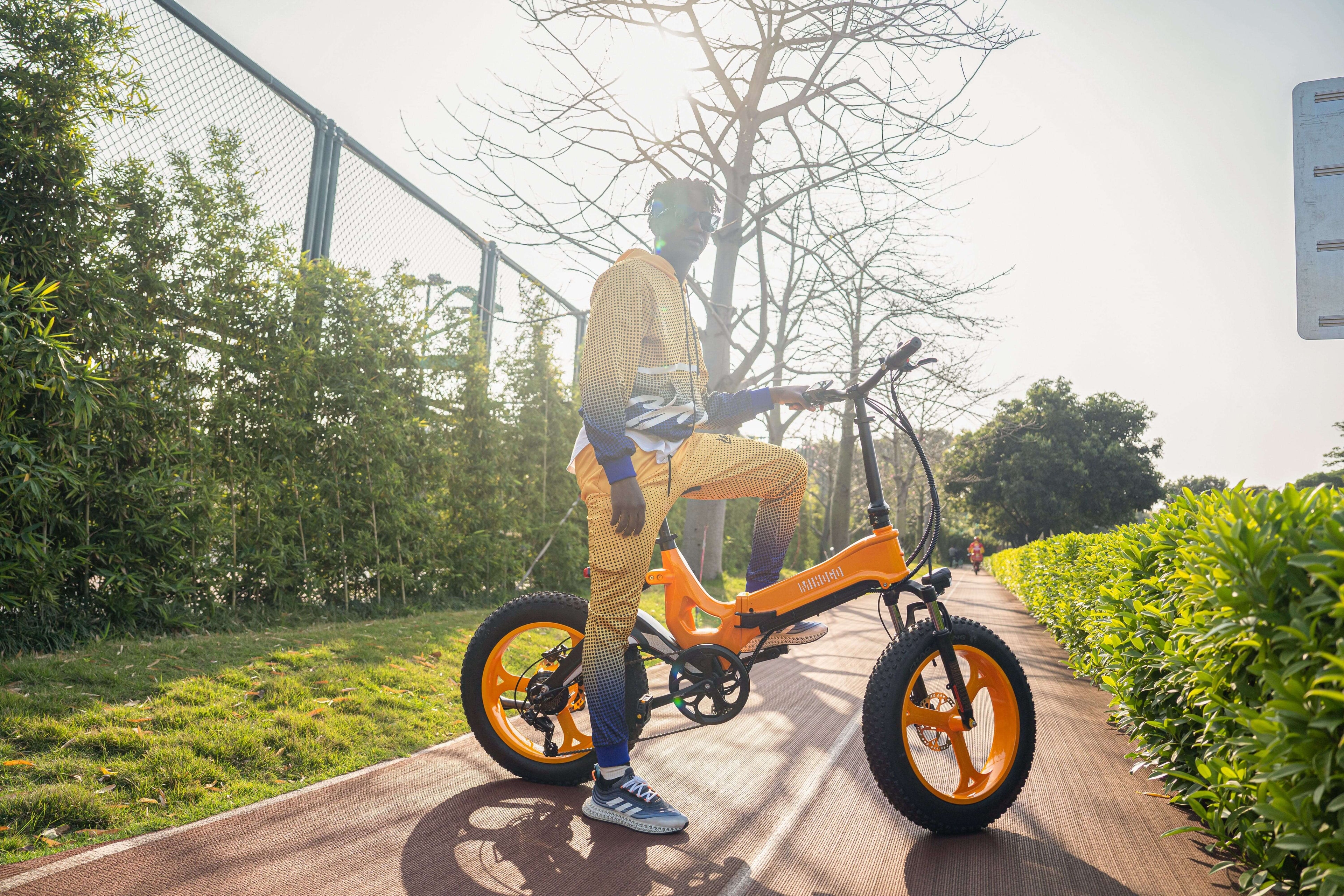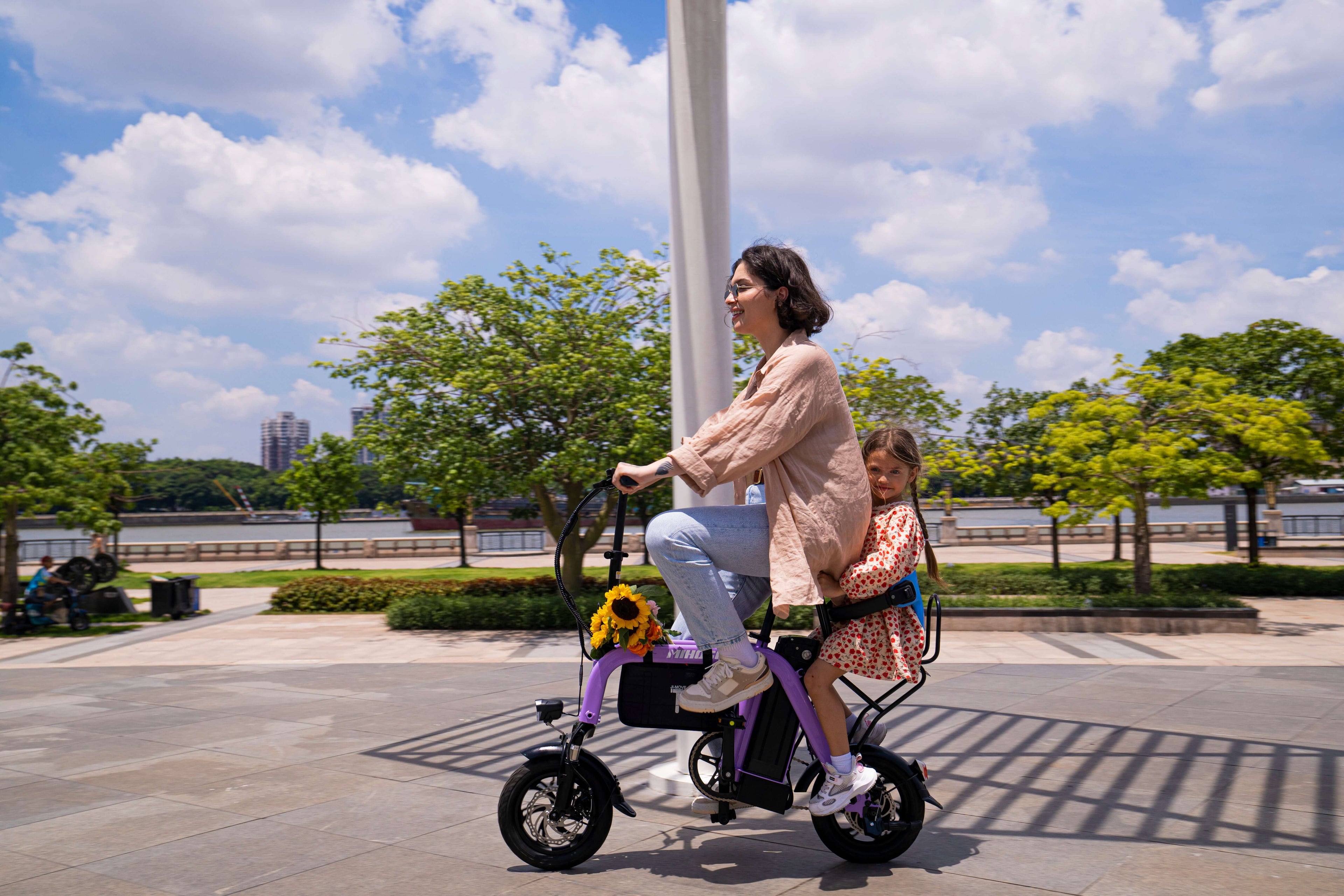Understanding Your Mihogo E-Bike Display System
Modern Mihogo electric bikes feature sophisticated LCD display systems that serve as your ride's command center. These smart displays provide real-time information about your bike's performance, battery status, and riding metrics - making them essential for safe and efficient e-bike operation.
Key Display Functions Across Mihogo Models:
- Speed monitoring (up to 25 MPH on Air750 Max and ONE Utility)
- Battery level indicators (121-mile range on Air750 Max, 167 miles on ONE Utility)
- Assist level controls (optimized for each model's power output)
- Trip distance tracking and odometer readings
- Error code displays for system diagnostics
- Power on/off controls and mode switching
Mihogo Model-Specific Display Features:
Air750 Max (750W, Carbon Fiber)
Best Terrain: Road cycling, long-distance touring, smooth trails Display Characteristics:
- High-contrast LCD optimized for outdoor visibility
- Advanced metrics display including power output
- Carbon frame integration requires specific mounting considerations
ONE Utility (750W, 167-mile range)
Best Terrain: Urban commuting, cargo hauling, mixed road surfaces Display Characteristics:
- Utility-focused interface with cargo monitoring
- Extended battery life indicators
- Heavy-duty mounting system for work environments
RX 2.4 (500W, Folding Commuter)
Best Terrain: City streets, public transport integration, compact storage Display Characteristics:
- Compact, folding-compatible display design
- Quick-access folding mode indicators
- Space-optimized button layout
Mini (350W, Urban Explorer)
Best Terrain: Bike paths, neighborhood cruising, casual rides Display Characteristics:
- Simplified, user-friendly interface
- Essential information focus
- Lightweight design integration
Common E-Bike Display Problems and Symptoms
Understanding the specific symptoms helps pinpoint the root cause and select the most effective repair approach. Here are the most frequent display issues Mihogo owners encounter:
1. Completely Blank or Dead Display
Symptoms:
- No lights, no response to button presses
- Display remains dark even when bike is powered on
- No backlight or screen activity
Most Likely Causes:
- Battery power issues (low charge or connection problems)
- Blown fuse in the electrical system
- Loose or damaged wiring connections
- Internal display unit failure
2. Flickering or Intermittent Display
Symptoms:
- Screen flickers on and off randomly
- Display works sometimes but cuts out during rides
- Inconsistent brightness or contrast
Most Likely Causes:
- Loose electrical connections
- Vibration-induced wiring issues
- Power supply fluctuations
- Moisture infiltration
3. Error Codes and Warning Messages
Symptoms:
- Display shows cryptic numbers (E01, E05, E30, etc.)
- Warning symbols or text messages
- Bike functions normally but displays error codes
Most Likely Causes:
- System diagnostics detecting component issues
- Software glitches requiring reset
- Sensor communication problems
- Controller malfunctions
4. Unresponsive Buttons or Controls
Symptoms:
- Display shows information but buttons don't work
- Cannot change assist levels or access menus
- Power button not responding properly
Most Likely Causes:
- Button mechanism wear or damage
- Water damage to control circuits
- Software freeze requiring reset
- Internal circuit board problems
5. Incorrect Data Display
Symptoms:
- Speed readings that don't match actual speed
- Inaccurate battery level indicators
- Wrong distance or time calculations
Most Likely Causes:
- Calibration issues with speed sensors
- Software bugs or corruption
- Magnetic interference
- Sensor alignment problems
Step-by-Step Diagnostic Process
Safety First: Pre-Repair Checklist
Before starting any display troubleshooting, follow these critical safety steps:
- Power Down Completely: Turn off your Mihogo e-bike using the main power button
- Remove the Battery: Disconnect the battery from its mounting point to eliminate electrical hazards
- Work in Dry Conditions: Never attempt repairs in wet or humid environments
- Use Proper Tools: Gather appropriate screwdrivers, multimeter, and cleaning supplies
- Document the Problem: Take photos of error codes or symptoms for reference
Step 1: Basic Power and Connection Check
Battery Health Verification
-
Check Battery Charge Level:
- Ensure battery is charged above 40%
- Use battery indicator lights if available
- Test with multimeter: 36V systems should read 38-42V when fully charged
-
Inspect Battery Connections:
- Clean battery terminals with dry cloth
- Check for corrosion (green/white buildup)
- Ensure tight, secure connections
-
Test Battery Mounting:
- Verify battery is properly seated in frame
- Check locking mechanism engagement
- Confirm all electrical contacts align properly
Display Wiring Inspection
-
Locate Display Cable Connections:
- Find main harness connection (usually near handlebars)
- Identify controller-to-display wiring path
- Check for visible damage along cable route
-
Connection Point Examination:
- Unplug and reconnect all display-related connectors
- Look for bent pins or damaged connectors
- Clean connections with electrical contact cleaner
Step 2: System Reset Procedures
Universal Mihogo Display Reset
-
Basic Reset Method:
- Power off bike completely
- Press and hold Power + Mode buttons simultaneously
- Hold for 10-15 seconds until screen flickers
- Release buttons and power on normally
-
Advanced Reset (If Basic Reset Fails):
- Disconnect battery for 5 minutes
- Reconnect battery and ensure all connections are secure
- Press and hold Power + UP + DOWN buttons together
- Hold for 20 seconds, then release and power on
Model-Specific Reset Procedures
Air750 Max Carbon Reset:
- Remove battery and wait 10 minutes (carbon frame can hold static charge)
- Reconnect battery and perform standard reset
- Check carbon frame grounding connections
ONE Utility Reset:
- Account for cargo accessories during reset
- Ensure all utility connections are secure
- May require additional controller reset for integrated accessories
RX 2.4 Folding Reset:
- Ensure bike is fully unfolded during reset
- Check folding mechanism electrical connections
- Verify display cable routing after folding/unfolding
Mini Model Reset:
- Use gentle pressure on compact buttons
- Check for button mechanism obstruction
- Clean around button areas before reset
Step 3: Advanced Electrical Diagnostics
Using a Multimeter for Testing
-
Display Power Supply Check:
- Set multimeter to DC voltage
- Test voltage at display connector
- Should read 36V (or 48V on some models)
-
Ground Connection Testing:
- Check continuity between display ground and frame
- Verify no resistance in ground circuits
- Test for short circuits
Controller Communication Testing
-
Data Line Inspection:
- Check communication cables for damage
- Test data signal continuity
- Verify proper connector seating
-
Controller Status Verification:
- Look for LED indicators on controller
- Check controller mounting and connections
- Test controller response to input signals
DIY Repair Solutions
Quick Fixes You Can Do at Home
Cleaning and Maintenance
Tools Needed: Soft cloth, electrical contact cleaner, compressed air, cotton swabs
-
Display Screen Cleaning:
- Use slightly damp cloth on screen surface
- Avoid harsh chemicals or abrasive materials
- Clean around buttons with cotton swabs
-
Connection Point Maintenance:
- Apply electrical contact cleaner to connections
- Use compressed air to remove debris
- Apply thin layer of dielectric grease for protection
Button Repair and Adjustment
Tools Needed: Small screwdriver, button contact cleaner
-
Stuck Button Resolution:
- Remove display unit (if possible)
- Clean around button mechanisms
- Apply contact cleaner to button circuits
-
Button Response Improvement:
- Check button spring mechanisms
- Clean oxidation from contact points
- Ensure proper button alignment
Electrical Connection Repairs
Wire and Connector Fixes
Tools Needed: Wire strippers, electrical tape, heat shrink tubing, soldering iron
-
Damaged Wire Repair:
- Cut out damaged section of wire
- Strip wire ends and splice with appropriate gauge wire
- Use heat shrink tubing for waterproof connections
-
Connector Replacement:
- Source compatible connectors from Mihogo or electronics supplier
- Carefully remove old connector
- Install new connector following original wiring diagram
Fuse Replacement
Tools Needed: Multimeter, replacement fuses
-
Fuse Location and Testing:
- Check your Mihogo manual for fuse locations
- Test fuse continuity with multimeter
- Replace blown fuses with exact same amperage rating
-
Fuse Installation:
- Ensure power is completely off
- Install new fuse in proper orientation
- Test system before full reassembly
Software and Firmware Solutions
Display Reset and Recalibration
Firmware Update Process
-
Check for Updates:
- Visit Mihogo support website
- Download latest firmware for your specific model
- Follow manufacturer instructions precisely
-
Update Installation:
- Connect display to computer (if supported)
- Follow update wizard instructions
- Never interrupt update process
Calibration Procedures
-
Speed Sensor Calibration:
- Access calibration menu through display settings
- Input correct wheel circumference for your model
- Test accuracy with known distance measurement
-
Battery Level Calibration:
- Fully charge battery before calibration
- Follow manufacturer's calibration sequence
- Allow full discharge/charge cycle to complete calibration
Model-Specific Troubleshooting
Air750 Max (750W Carbon) - Advanced Solutions
Common Issues:
- Carbon frame interference with display signals
- High-power system electrical noise
- Temperature sensitivity in extreme conditions
Specific Solutions:
-
Signal Interference Resolution:
- Check carbon frame grounding points
- Verify shielded cable routing
- Add ferrite cores to reduce electromagnetic interference
-
Power Management:
- Monitor system voltage under load
- Check high-current connections for voltage drop
- Verify controller cooling during extended high-power operation
ONE Utility (750W, Long Range) - Utility-Focused Fixes
Common Issues:
- Display problems when carrying heavy loads
- Accessory integration conflicts
- Extended range battery monitoring accuracy
Specific Solutions:
-
Load-Related Display Issues:
- Check frame flex impact on wiring
- Verify heavy-duty connector ratings
- Monitor voltage stability under cargo load
-
Accessory Integration:
- Verify accessory power draw doesn't exceed limits
- Check for ground loops in accessory wiring
- Ensure proper accessory fusing
RX 2.4 (500W Folding) - Compact System Solutions
Common Issues:
- Folding mechanism damage to display cables
- Compact button functionality problems
- Space-constrained repair access
Specific Solutions:
-
Folding Mechanism Protection:
- Inspect cable routing through folding joints
- Add cable protection where needed
- Verify proper cable length and slack
-
Compact Display Service:
- Use precision tools for small components
- Check for cable pinching in compact frame
- Ensure proper cable strain relief
Mini (350W Urban) - Simplified System Repairs
Common Issues:
- Simplified display feature limitations
- Compact button wear from frequent use
- Basic system troubleshooting challenges
Specific Solutions:
-
Simplified Diagnostics:
- Focus on essential system functions
- Use basic multimeter testing
- Check fundamental power and ground connections
-
Button Longevity:
- Implement regular button cleaning schedule
- Use appropriate button press force
- Monitor for early wear indicators
Professional Service and When to Seek Help
Warning Signs That Require Professional Attention
-
Electrical Safety Concerns:
- Burning smells from display or controller
- Sparking or electrical arcing
- Repeated fuse failures
-
Complex Internal Failures:
- LCD screen damage requiring replacement
- Internal circuit board failures
- Water damage to electronic components
-
Warranty Considerations:
- Display still under manufacturer warranty
- Uncertain about proper repair procedures
- Risk of voiding warranty with DIY repairs
Finding Qualified Mihogo Service
Authorized Service Centers
- Certified Mihogo technicians with specific model training
- Genuine replacement parts and proper diagnostic equipment
- Warranty preservation and professional documentation
Local E-Bike Shops
- General e-bike experience may be sufficient for basic issues
- Parts availability may require special ordering
- Verify experience with LCD display systems before service
Preventive Maintenance for Display Longevity
Daily and Weekly Checks
Pre-Ride Display Inspection
-
Visual Check:
- Verify display powers on properly
- Check for cracks or damage to screen
- Ensure all buttons respond correctly
-
Function Test:
- Cycle through all display modes
- Verify accurate speed and battery readings
- Test assist level controls
Weekly Maintenance
-
Cleaning Routine:
- Wipe display screen with appropriate cleaner
- Clean around buttons and connections
- Remove dirt and debris from mounting area
-
Connection Check:
- Verify all connectors remain tight
- Check for signs of corrosion or wear
- Ensure proper cable routing and protection
Seasonal Maintenance
Weather Protection
-
Rain and Moisture:
- Check weatherproofing seals regularly
- Apply dielectric grease to connections
- Ensure proper drainage around display
-
Temperature Extremes:
- Monitor display performance in cold weather
- Protect from direct sunlight when parked
- Allow gradual temperature adjustment
Storage Considerations
-
Long-Term Storage:
- Remove battery to prevent deep discharge
- Store in controlled temperature environment
- Cover display to protect from dust and debris
Troubleshooting Error Codes
Common Mihogo Error Codes and Solutions
Power and Battery Errors
- E01: Battery communication error - Check battery connections
- E02: Battery voltage low - Charge battery fully
- E03: Battery temperature protection - Allow cooling/warming
Motor and Controller Errors
- E05: Throttle error - Check throttle connection and calibration
- E06: Motor error - Inspect motor connections and hall sensors
- E07: Controller error - May require controller reset or replacement
Sensor and Communication Errors
- E30: Communication error - Check all system connections
- E62: Firmware update error - Contact technical support
- Speed sensor errors: Check magnet alignment and sensor position
Error Code Reset Procedures
-
Temporary Error Resolution:
- Power cycle the system
- Check related component connections
- Clear error and test system function
-
Persistent Error Handling:
- Document error frequency and conditions
- Check service manual for specific solutions
- Contact technical support with error details
Advanced Repair Techniques
Component-Level Diagnostics
Circuit Board Inspection
Tools Needed: Magnifying glass, multimeter, oscilloscope (advanced)
-
Visual Inspection:
- Look for burnt components or traces
- Check for cracked solder joints
- Identify corrosion or moisture damage
-
Electrical Testing:
- Test component values against specifications
- Check for short circuits or open connections
- Verify signal integrity on data lines
Display Screen Replacement
Tools Needed: Precision screwdrivers, anti-static equipment
-
Screen Removal:
- Carefully disassemble display housing
- Document cable connections with photos
- Use proper anti-static precautions
-
Installation:
- Verify replacement screen compatibility
- Connect cables in exact original configuration
- Test functionality before final assembly
Cost-Effective Repair Strategies
Budget-Friendly Solutions
DIY Repair Priorities
-
High-Impact, Low-Cost Fixes:
- Connection cleaning and maintenance
- Basic button repairs and adjustments
- Simple wiring fixes and fuse replacement
-
Tool Investment:
- Quality multimeter for diagnostics
- Basic electrical repair supplies
- Proper cleaning and maintenance materials
Professional Service Value
When Professional Service Makes Sense
-
Warranty Protection:
- Preserve manufacturer warranty coverage
- Ensure proper repair documentation
- Access to genuine replacement parts
-
Complex Repairs:
- Internal circuit board work
- Firmware and software issues
- Integration with other bike systems
Smart Technology Integration
Modern Display Features
Connectivity and Smart Functions
-
App Integration:
- Smartphone connectivity for advanced diagnostics
- Remote display configuration and updates
- Performance tracking and ride analytics
-
GPS and Navigation:
- Built-in GPS functionality troubleshooting
- Navigation display issues and solutions
- Location tracking and anti-theft features
Future-Proofing Your Mihogo
-
Software Updates:
- Regular firmware updates for improved functionality
- New feature additions through updates
- Bug fixes and performance improvements
-
Technology Evolution:
- Preparation for emerging display technologies
- Compatibility considerations for future accessories
- Smart bike integration possibilities
Environmental Considerations
Weather and Climate Impact
Display Performance in Various Conditions
-
Temperature Effects:
- Cold weather LCD response issues
- High temperature protection and cooling
- Thermal expansion considerations for connections
-
Moisture and Humidity:
- Waterproofing maintenance and inspection
- Condensation prevention strategies
- Corrosion protection for electrical components
Terrain-Specific Considerations
-
Urban Environments:
- Dust and pollution impact on display longevity
- Vibration from rough city streets
- Security considerations for valuable display units
-
Off-Road and Trail Riding:
- Impact and shock protection
- Mud and debris protection strategies
- Trail-specific display durability requirements
Conclusion
A properly functioning display is essential for safe and enjoyable riding on your Mihogo electric bike. Whether you're navigating city streets on your compact RX 2.4, hauling cargo with your versatile ONE Utility, touring long distances on your efficient Air750 Max, or cruising neighborhoods on your nimble Mini, a reliable display keeps you informed and in control.
Remember that most display problems have straightforward solutions when approached systematically. Start with basic checks - power connections, battery charge, and simple resets - before moving to more advanced diagnostics. Many issues can be resolved with proper cleaning, connection maintenance, and basic electrical knowledge.
Key Takeaways for Mihogo Owners:
- Regular maintenance prevents most display problems
- Safety first - always power down before repairs
- Model-specific considerations matter for effective troubleshooting
- Professional help is valuable for complex issues or warranty concerns
Don't let display problems sideline your Mihogo e-bike. With the right knowledge and approach, you can keep your display functioning perfectly and get back to enjoying the freedom and efficiency that makes Mihogo electric bikes such excellent transportation choices.
External Resources
- Electric Bicycle Technology and Safety - Wikipedia
- Professional E-Bike Maintenance Guidelines - REI Expert Advice
- E-Bike Safety and Maintenance Best Practices - BikeRada
- Battery Diagnostics and Repair - Complete guide to Mihogo battery troubleshooting and maintenance
- Controller and Electrical System Repair - Advanced electrical troubleshooting for all Mihogo models








